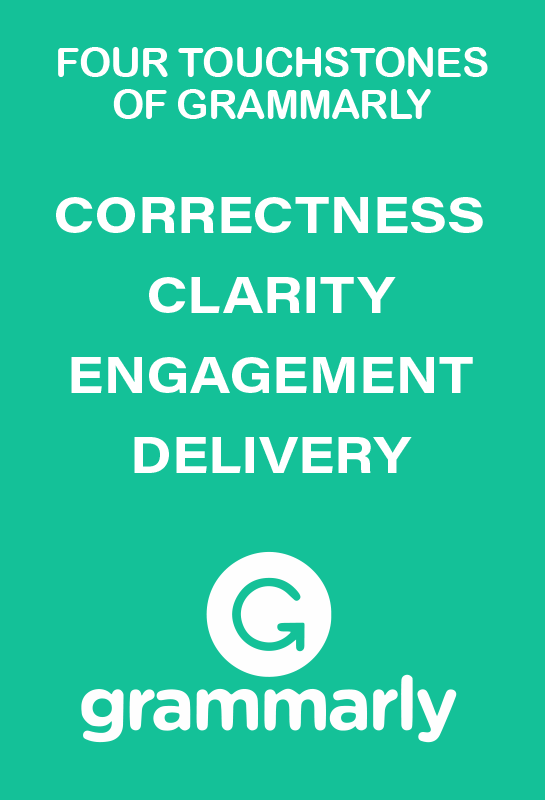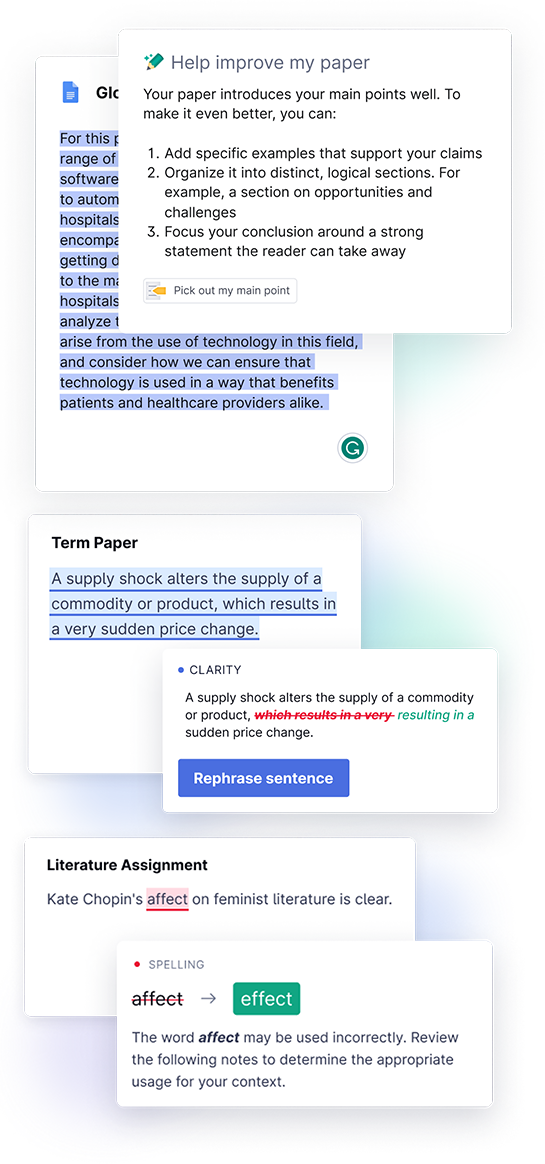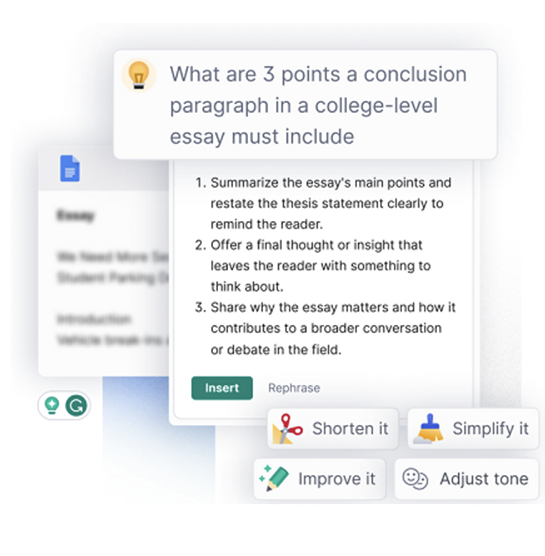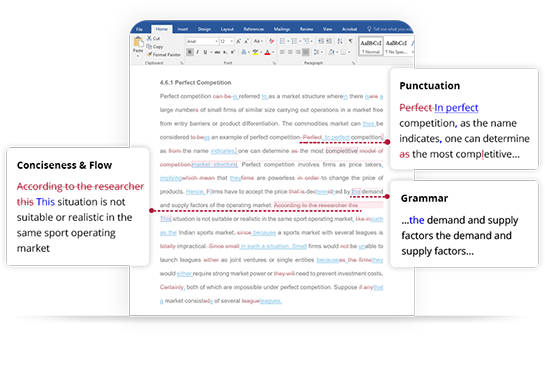Grammarly’s Role in Student Achievement with Bryan Libbin, Associate CIO for Academic Technology and Learning Innovation
quote Heading link
Beyond mere error identification, Grammarly proves to be a valuable resource for vocabulary expansion and structural refinement. It goes beyond pointing out mistakes; it actively engages with language use, suggesting alternative words, and addressing issues related to sentence structure.

At the heart of every academic institution lies a commitment to empowering students with the tools and resources they need to succeed. In line with this philosophy, Learning Technology Solutions is indicating our commitment to student success by piloting Grammarly, a cutting-edge writing assistance tool. Designed to encourage student achievement and reinforce student writing capabilities, Grammarly represents a significant step forward in our dedication to fostering a student-centered learning environment.
To shed light on the ways Grammarly aligns with our commitment to student success, LTS sat down with Bryan Libbin, the Associate CIO for Academic Technology and Learning Innovation at Technology Solutions. He shares invaluable insights into the implications of integrating Grammarly into our edtech ecosystem and how it magnifies our focus on supporting students in their learning.
Hi Bryan, thank you again for doing this interview with us. Can you elaborate on how Grammarly aligns with our UIC’s student-centered approach to learning and academic success?
The decision to pilot Grammarly was a multifaceted process, shaped by an examination of various factors aimed at optimizing support provided to students. First, we delved into the existing usage of Grammarly among students on campus, uncovering that approximately 1100 users had already embraced the platform. These users collectively invested around $77,000 annually in utilizing Grammarly’s services. It’s important to underscore that this financial snapshot does not encompass faculty, staff, or students whose Grammarly accounts are associated with non-UIC email addresses. This financial perspective provided a quantitative foundation for understanding the scale of Grammarly’s adoption and its associated economic implications.
A second consideration involved contemplating the unique challenges faced by students who reside off-campus and commute. Recognizing the diverse environments in which students engage with their academic work, Grammarly stood out as a valuable solution by offering continuous 24/7 writing support. Whether students found themselves at home, commuting on public transportation, or present on campus, Grammarly’s accessibility addressed the need for flexible assistance tailored to the prevalent lifestyles of our student body.
The decision to explore AI support tools, including Grammarly, was underpinned by a strategic objective to create controlled and secure environments for implementation. Grammarly’s track record of leveraging artificial intelligence over an extended period positioned it as a promising candidate for this initiative. The emphasis was on adopting tools that align with UIC’s commitment to enhancing student learning. It’s important to understand, that the intention is not to substitute active student engagement but rather to strike a delicate balance where technology, such as Grammarly, serves as a facilitator for improvement without overshadowing the need for students to actively participate in the learning and writing process. This nuanced approach reflects a commitment to integrating technology seamlessly into the academic landscape while fostering a culture of independent and critical thinking among students. This also provides us with the chance to instruct our students in the correct utilization of AI and the creation of prompts, a crucial skill for the contemporary workforce.
In what specific ways do you envision Grammarly benefiting our students in terms of their writing proficiency and academic achievements? Are there any features or functionalities that you’d like to highlight?
As previously mentioned, I am optimistic about the impact Grammarly can have, functioning as a comprehensive 24/7 writing tutor that extends support across various facets of the writing spectrum. This assistance is not confined to traditional academic papers but encompasses the broader spectrum of written communication, including emails and even discussion boards. The potential for Grammarly to be most influential lies in its ability to pinpoint nuances, particularly in tone—a critical element often overlooked. Grammarly has the capacity to enhance the subtleties of expression and communication, fostering more refined and effective writing.
text 3 Heading link

Beyond mere error identification, Grammarly proves to be a valuable resource for vocabulary expansion and structural refinement. It goes beyond pointing out mistakes; it actively engages with language use, suggesting alternative words, and addressing issues related to sentence structure. Over time, this interactive process contributes to the organic growth of a student’s linguistic proficiency, enabling them not only to rectify errors but also to autonomously incorporate stylistic improvements into their writing. This aspect aligns with the broader goal of education—to equip students with the skills and knowledge that empower them to become adept, self-sufficient learners.
An equally significant benefit of integrating Grammarly into our academic environment is its role in democratizing access to advanced writing assistance. Historically, such applications were often accessible only to those students who could afford them. Acquiring Grammarly levels the playing field, ensuring that all students have access to this tool. This inclusivity aligns with principles of equity and access, ensuring that each student has the opportunity to enhance their writing skills and succeed academically, irrespective of economic considerations. In essence, Grammarly not only functions as a writing aid but also contributes to creating a more equitable educational landscape.
What strategies or support mechanisms are in place to ensure students make optimal use of Grammarly and leverage it effectively?
Our approach to implementing Grammarly within our educational framework involves a comprehensive strategy aimed at ensuring both students and faculty derive maximum benefit from this writing assistance tool. We recognize the importance of a clear and accessible onboarding process, and to facilitate this, we will develop instructions to guide students through the initial steps of using Grammarly. Recognizing the varied learning preferences of our students, we will complement these written instructions with a video tutorial. Additionally, we envision the creation of a supplementary video, focusing specifically on best practices for leveraging Grammarly effectively in the writing process.
Acknowledging the crucial role of faculty in guiding students and integrating technology into the academic landscape, we are committed to developing tailored instructions for instructors. These instructions will encompass not only best practices in utilizing Grammarly but also explore assessment use cases, offering insights into how Grammarly can be strategically incorporated into grading and feedback processes.
Collaboration with Grammarly is a key component of our strategy. Our Learning Technology Services (LTS) team will work closely with Grammarly to utilize available resources and ensure that both students and faculty are aware of the full spectrum of capabilities Grammarly offers. This collaborative effort extends beyond initial onboarding, with ongoing support mechanisms in place to address evolving needs and facilitate continuous improvement.
text block 2 Heading link

From a pedagogical standpoint, how might instructors integrate Grammarly into their teaching methodologies to support student learning?
Integrating Grammarly into teaching methodologies presents a valuable opportunity for instructors to enhance student learning through various pedagogical strategies. To initiate this incorporation, early in the semester, instructors can introduce Grammarly, acquainting students with its features, and offering guidance on effective usage. In-class demonstrations could serve as a pivotal strategy to illustrate how Grammarly operates and can be seamlessly integrated into the writing process. Instructors can showcase specific features, including grammar checking, plagiarism detection, and style suggestions, allowing students to gain a hands-on understanding of the tool’s functionalities.
Encouraging students to utilize Grammarly for individualized feedback on their writing assignments is another essential pedagogical approach. Instructors can underscore the significance of not only receiving suggestions but also comprehending and incorporating them to augment overall writing skills.
Peer review sessions incorporating Grammarly provide an avenue for collaborative learning. Students can use the tool to review each other’s work, fostering constructive feedback based on Grammarly suggestions. This collaborative approach not only enhances individual writing skills but also promotes a shared learning experience.
The integration of Grammarly into writing workshops or centers offers real-time feedback on drafts, creating an interactive environment for students. Instructors can use Grammarly as a catalyst for discussions on common writing challenges and strategies for improvement. Customized writing exercises targeting identified grammar and writing issues through Grammarly reports further tailor the learning experience.
Incorporating Grammarly into assessments, either as part of grading criteria or as a self-assessment tool, ensures that the tool becomes an integral aspect of the evaluation process. In emphasizing its use alongside other proofreading and editing strategies, instructors guide students to develop a comprehensive approach to refining their writing.
Encouraging reflection on Grammarly feedback and iterative use of the tool in the revision process contribute to continuous improvement in writing skills. If Grammarly integrates with the institution’s Learning Management System (LMS), leveraging this integration can streamline submission and feedback processes.
Of equal importance, is fostering an open dialogue about writing skills and addressing any concerns or misconceptions students may have about over-reliance on automated tools is crucial. Instructors play a pivotal role in guiding students to strike a balance between leveraging technology tools like Grammarly and independently developing their writing and editing skills. This dual approach ensures that technology serves as a supplement rather than a replacement for students’ understanding of grammar and writing conventions.
Given the emphasis on academic integrity, how does Grammarly promote originality while assisting students in improving their writing?
Grammarly, as a writing assistance tool, is strategically designed to foster originality while simultaneously aiding students in refining their writing skills. One key aspect is Grammarly’s plagiarism detection feature, which scans texts for similarities within an extensive database of academic and online content. By pinpointing potential instances of plagiarism, Grammarly serves as a valuable resource in helping students rectify unintentional or improper use of external sources. Additionally, the tool provides citation suggestions, guiding students in proper source crediting and mitigating the risk of unintentional plagiarism.
Grammarly’s role in offering not only correction but also educational feedback on grammar, punctuation, and writing style, empower students to comprehend rules and conventions for informed decision-making in their writing and guide students to adhere to academic writing standards, contributing to the creation of original and academically sound writing. Furthermore, the tool’s focus on enhancing writing quality without generating content or ideas places the responsibility for original thought squarely on the student, encouraging clear and authentic expression.
However, it is important to note, that students should be encouraged to complement its use with their own critical thinking, research, and understanding of the subject matter. Instructors play a crucial role in educating students about the appropriate use of Grammarly and reinforcing principles of academic integrity throughout the writing process.
text 4 Heading link

As our campus pilots Grammarly, what measures are being taken to gather feedback and assess its effectiveness in supporting student success, and what is the envisioned timeline for its potential integration across the university?
Our assessment of Grammarly’s impact within our university community during this one-year pilot is centered on three key metrics. First, we will closely examine the adoption rates, aiming to understand the extent to which students, staff, and faculty are using the university-wide license for Grammarly. This initial metric provides insights into the overall acceptance and interest in incorporating this writing assistance tool into the academic landscape.
The second metric used in our evaluation focuses on the usage patterns of Grammarly. We delve into questions surrounding the frequency of use and the amount of time individuals invest in utilizing Grammarly. This exploration is pivotal in gauging the tool’s integration into daily academic workflows and the level of engagement it elicits.
To gather qualitative insights into the perceived impact and utility of Grammarly, the third metric involves conducting surveys among students, faculty, and staff. Understanding firsthand experiences, challenges faced, and benefits gained from using this application is crucial in shaping our understanding of its efficacy. Collaboration with Student Success and Belonging extends this feedback loop to include insights from writing advisors, offering a comprehensive view of the tool’s influence on writing support services.
Furthermore, we recognize the importance of departmental feedback, considering the varied academic contexts and writing demands across disciplines. Input from departments adds a layer of specificity to our evaluation, helping us tailor our approach to different academic needs.
It’s essential to acknowledge the complexity of measuring long-term impacts on writing skills within a single academic year. Consequently, we prioritize these metrics—adoption rates, usage patterns, and qualitative feedback—as foundational indicators to guide our decision-making process for potential second-year adoption. By triangulating data from multiple sources, we aim to gain a nuanced understanding of Grammarly’s role in our academic ecosystem, ensuring that any decisions about its sustained adoption are informed by a comprehensive and evidence-based assessment.
text 5 Heading link

Any last thoughts, and how do we sign up to participate?
The pilot will begin later this spring, and all faculty, staff, and students will be sent instructions on how to activate their accounts.
It is crucial to recognize that Grammarly is a supportive tool among many that our school offers to assist our students in enhancing their writing and communication skills. It is not a flawless application that guarantees perfect writing. Research has highlighted its issues, biases, mistakes, and the ability to alter the tone of a piece. Nevertheless, by approaching Grammarly as supplementary support, and as a university we foster a community that encourages and models its effective utilization and instruct our students to leverage all available resources to enhance their writing skills, we can make a positive impact on both student support and the overall quality of writing at UIC.
Thank you, Bryan, and thank you for your efforts in bringing this tool to the campus!
The introduction of Grammarly at UIC is a proactive step towards enhancing student achievement and academic success. By providing this state-of-the-art writing tool, we are equipping our students with resources that refine their writing skills, foster autonomy, and promote academic integrity. The Learning Technology Solutions team encourages all faculty and instructors to take an active role in this pilot by incorporating Grammarly into their pedagogy and providing feedback on its effectiveness.
To ensure the success of this initiative, we urge faculty to:
- Familiarize themselves with Grammarly by attending the upcoming workshops and accessing the resources provided by LTS.
- Integrate Grammarly into their teaching methodologies and assessments to bolster students’ writing proficiency.
- Encourage students to use Grammarly for various writing tasks and reflect on the feedback it provides.
- Provide LTS with feedback in upcoming surveys on Grammarly’s role in the classroom and its impact on student writing.
We invite all UIC staff and instructors to join us in this endeavor by creating a Grammarly account, details of which will be communicated shortly via official university channels. Together, we can leverage technology to build a stronger foundation for our students’ academic growth and success. LTS would be happy to work with faculty in 1:1 consultations or in workshops if departments or units would prefer a group approach to integrate the tool.